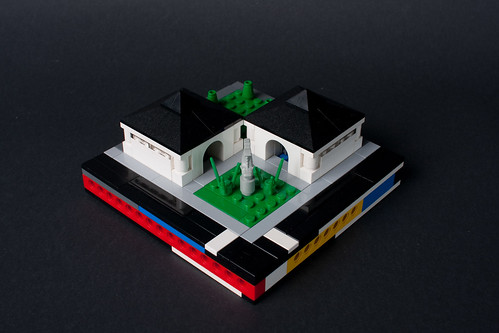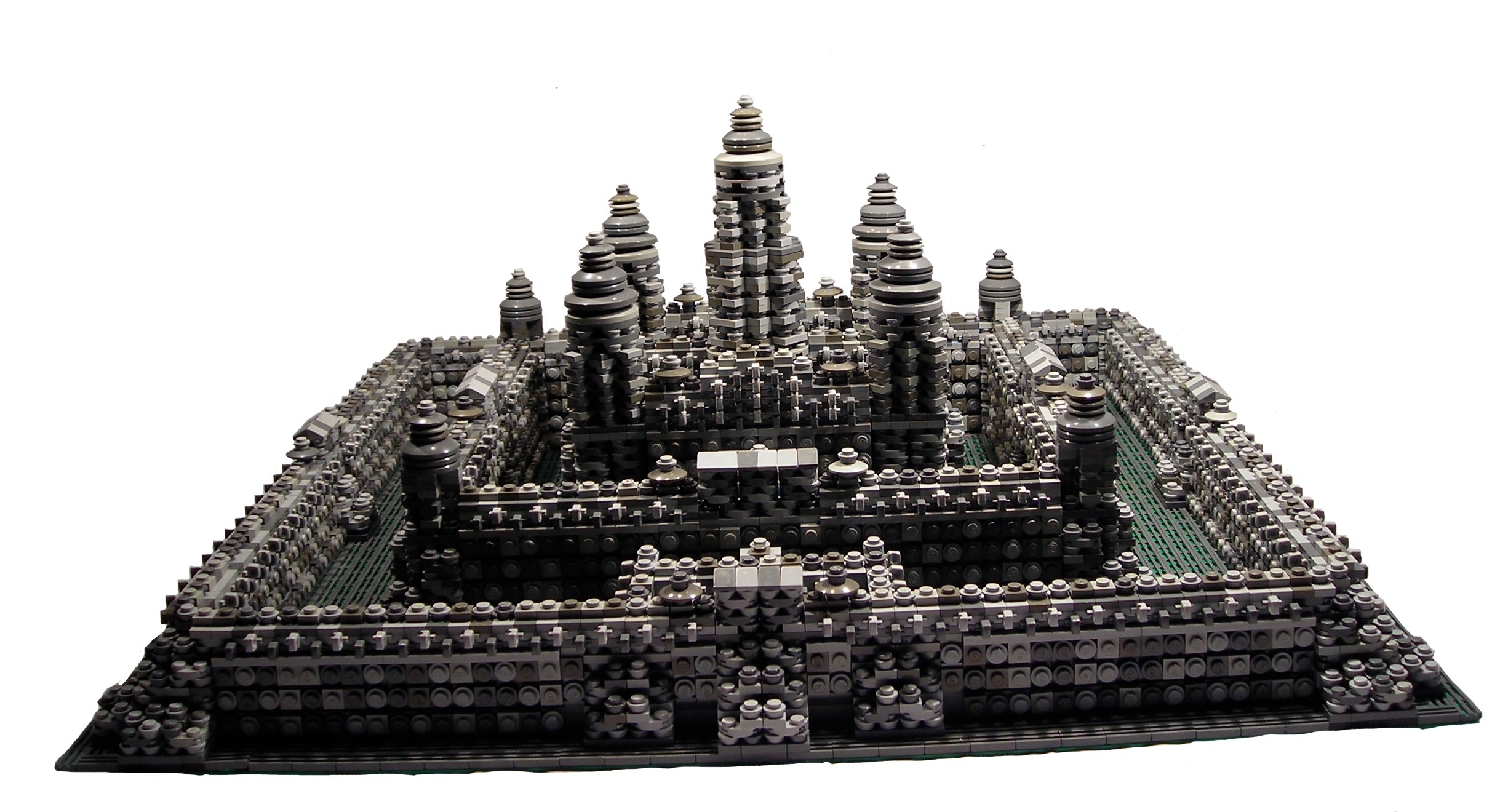
| Please visit the other 'Bricks' blogs: |
|
Saturday, May 29, 2010
Angkor Wat
Angkor Wat is surely the most recognizable site in Cambodia. It was first built as a Hindu temple over 800 years ago, and was later rededicated as a Buddhist temple. Here Arthur Gugick gives us a LEGO rendition.


Thursday, May 27, 2010
Madonna and child
On Flickr, Moosebot has developed what he calls midi-figs, LEGO characters at about half the size of a minifig. This month he's been presenting a new one each day, with a range of characters from knights in armor, to Star Wars characters, to comic book superheroes, to Neil Armstrong. Today he presents Mary and Jesus. BTW, if you follow that link, there's a discussion there about Catholic views on Mary and the saints.


Monday, May 24, 2010
LEGO: A Love Story
Hi. I'm posting a copy of this book review to each of my four blogs. However, if you read more than one of my blogs, I'm including a unique paragraph to the end on each blog noting specifics of the book relevant to the topic of that blog.
Review: A couple of years ago, I remember hearing on one of the LEGO forums about Jonathan Bender, a journalist who was planning on spending a year exploring the AFOL community as part of a writing project. He started a blog, Brick Bender, to document his journey. I read a few entries, but there are so many different blogs and websites out there that I kind of forgot about it. Recently, though, this exploration came to fruition in a new book, LEGO: A Love Story.

The result is a highly enjoyable book. Jonathan follows the journey that many of us took. He remembers playing with LEGO as a kid, but then goes into a long dark age. Little things remind him of his hobby, and eventually he digs his old bricks out of his parents' basement. He nervously buys new LEGO for himself, afraid that others might learn of his purchase. Then he starts building MOCs. He connects with the community, and is initially nervous that his MOCs won't measure up to the amazing models he sees.
Along the way, Jonathan met up with a great number of people from the AFOL community. One of the first things I noticed when flipping through the book was that it has a great index, and, yes, I looked myself up. To my utter surprise, delight, and honor, there I was. On page 106 he quotes something I posted on Lugnet several years ago about vignettes. But I'm a minor player, of course. He talks to a great number of the major players in the AFOL world, from bloggers to fest organizers, to current and former LEGO employees. He also researches the LEGO company and the growth of the fan community, with a lot of the major events along the way. He travels to several fan events like Brick World, Brick Bash, Brick Show, and BrickCon (hmm, see a pattern in fan fest names?) and gets behind the scenes tours at the Toy and Plastic Brick Museum, Legoland California, and the homeland itself, LEGO headquarters in Billund. And he invites us all along for the ride.
There are several audiences for this book. If you are just interested in the hobby as an outsider, particularly if you are, say, the spouse of an AFOL, he gives a great insight into these crazy people and their plastic brick masterpieces. If you are just coming out of your own dark age, you can learn a ton about the hobby and the people in it. If you're someone who's been in the hobby for years, it's like going to a reunion, where you encounter old friends and share great memories.
Are there shortcomings in this book? Yes, of course. No book can hope to be a comprehensive view of such a large and diverse community. I saw a couple of small errors, and places where I remember events a little differently than he reports. It felt in places like he gave a larger weight to some individuals because he got to know them personally, while other very important members of the community were missed, especially those outside the US. I do wish that he'd spent more time on the evolution of the on-line side of the Legoverse. He has a good picture of the growth from Usenet newsgroups to Lugnet. But as he reports, Lugnet is pretty dead these days, and he doesn't really go into the way that other, more specific forums grew out of Lugnet, or the variety of blogs (other than the Brothers Brick, which he rightly points out as the most important LEGO blog) and Flickr groups. The other thing I really felt the book needed was more pictures. There are black and white photos at the start of each chapter, and eight pages of glossy color photos in the center, but with such a visual medium you could have put photos on almost every page. As a pretty active AFOL I remember a lot of the different MOCs he mentions, but someone less involved in the hobby would benefit from photos of these. I want to reread the book with Jonathan's blog open in front of me, so that I can go back and forth and see his photos along with the events he describes.
The book is intensely personal. In addition to inviting us in to his own feelings as he becomes an AFOL - the fun of discovery, the nervousness about others learning about his hobby, the fear that his efforts would not be accepted by other AFOLs - he invites us deeper. We get to see him building LEGO with his dad as a child, and then again reconnecting through LEGO as an adult. Even more personally, we get his and his wife's fears that they may never have children of their own. I'm not afraid to admit that my eyes were tearing up at the emotional climax in the last few pages. This is ultimately a book about love. Yes, we all share a love for little plastic bricks, but in the end it is about love between people - the lasting friendships built up between community members, the love of a husband and wife, the love of a parent and child. That's what makes this hobby so special, and that's what this book celebrates.
GodBricks specific material: Jonathan has a discussion with Brendan Powell Smith about the Brick Testament. He also has a passing reference to these crosses produced by the LEGO company in their early years of molding plastic. He also talks with Brian Korte of Brickworkz, who has been featured here before.
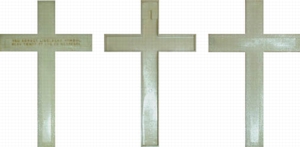
Review: A couple of years ago, I remember hearing on one of the LEGO forums about Jonathan Bender, a journalist who was planning on spending a year exploring the AFOL community as part of a writing project. He started a blog, Brick Bender, to document his journey. I read a few entries, but there are so many different blogs and websites out there that I kind of forgot about it. Recently, though, this exploration came to fruition in a new book, LEGO: A Love Story.

The result is a highly enjoyable book. Jonathan follows the journey that many of us took. He remembers playing with LEGO as a kid, but then goes into a long dark age. Little things remind him of his hobby, and eventually he digs his old bricks out of his parents' basement. He nervously buys new LEGO for himself, afraid that others might learn of his purchase. Then he starts building MOCs. He connects with the community, and is initially nervous that his MOCs won't measure up to the amazing models he sees.
Along the way, Jonathan met up with a great number of people from the AFOL community. One of the first things I noticed when flipping through the book was that it has a great index, and, yes, I looked myself up. To my utter surprise, delight, and honor, there I was. On page 106 he quotes something I posted on Lugnet several years ago about vignettes. But I'm a minor player, of course. He talks to a great number of the major players in the AFOL world, from bloggers to fest organizers, to current and former LEGO employees. He also researches the LEGO company and the growth of the fan community, with a lot of the major events along the way. He travels to several fan events like Brick World, Brick Bash, Brick Show, and BrickCon (hmm, see a pattern in fan fest names?) and gets behind the scenes tours at the Toy and Plastic Brick Museum, Legoland California, and the homeland itself, LEGO headquarters in Billund. And he invites us all along for the ride.
There are several audiences for this book. If you are just interested in the hobby as an outsider, particularly if you are, say, the spouse of an AFOL, he gives a great insight into these crazy people and their plastic brick masterpieces. If you are just coming out of your own dark age, you can learn a ton about the hobby and the people in it. If you're someone who's been in the hobby for years, it's like going to a reunion, where you encounter old friends and share great memories.
Are there shortcomings in this book? Yes, of course. No book can hope to be a comprehensive view of such a large and diverse community. I saw a couple of small errors, and places where I remember events a little differently than he reports. It felt in places like he gave a larger weight to some individuals because he got to know them personally, while other very important members of the community were missed, especially those outside the US. I do wish that he'd spent more time on the evolution of the on-line side of the Legoverse. He has a good picture of the growth from Usenet newsgroups to Lugnet. But as he reports, Lugnet is pretty dead these days, and he doesn't really go into the way that other, more specific forums grew out of Lugnet, or the variety of blogs (other than the Brothers Brick, which he rightly points out as the most important LEGO blog) and Flickr groups. The other thing I really felt the book needed was more pictures. There are black and white photos at the start of each chapter, and eight pages of glossy color photos in the center, but with such a visual medium you could have put photos on almost every page. As a pretty active AFOL I remember a lot of the different MOCs he mentions, but someone less involved in the hobby would benefit from photos of these. I want to reread the book with Jonathan's blog open in front of me, so that I can go back and forth and see his photos along with the events he describes.
The book is intensely personal. In addition to inviting us in to his own feelings as he becomes an AFOL - the fun of discovery, the nervousness about others learning about his hobby, the fear that his efforts would not be accepted by other AFOLs - he invites us deeper. We get to see him building LEGO with his dad as a child, and then again reconnecting through LEGO as an adult. Even more personally, we get his and his wife's fears that they may never have children of their own. I'm not afraid to admit that my eyes were tearing up at the emotional climax in the last few pages. This is ultimately a book about love. Yes, we all share a love for little plastic bricks, but in the end it is about love between people - the lasting friendships built up between community members, the love of a husband and wife, the love of a parent and child. That's what makes this hobby so special, and that's what this book celebrates.
GodBricks specific material: Jonathan has a discussion with Brendan Powell Smith about the Brick Testament. He also has a passing reference to these crosses produced by the LEGO company in their early years of molding plastic. He also talks with Brian Korte of Brickworkz, who has been featured here before.

Monday, May 17, 2010
Saturday, May 15, 2010
And on the sixth day ...
Brucey-wan shows us creation out of the clay of the ground. In case you don't know, those little pellets are the raw plastic that is molded into LEGO pieces like that minifig.
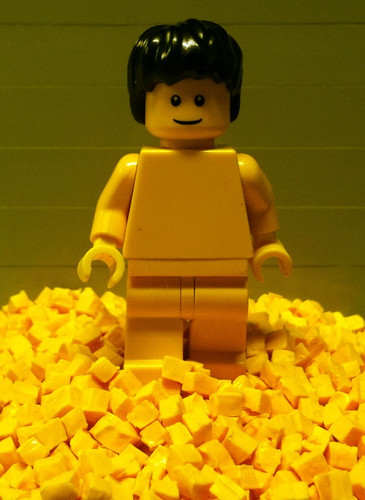

Friday, May 14, 2010
Monday, May 10, 2010
From the new to the old
After just posting Tony Sava's masterpiece, the most recent large cathedral incorporating all kinds of modern building techniques, let's turn to one of the oldest large cathedral MOCs. Diepuppenstubensam has been posting old LEGO advertisements, including this Cologne Cathedral from a 1959 ad in Das Spielzeug, or The Toy, a toy industry magazine. The text says that this construction proves the quality and precision (presumably of LEGO as a building toy). Realize that this is back when only basic bricks, plates and slopes were available.


Saturday, May 8, 2010
Cathedral of Saint Francis
Those in the LEGO hobbyist community are probably already aware of Tony Sava's great Cathedral of Saint Francis, but I think (hope) that I also have readers from outside the LEGO community who found my blog due to their interest in religious topics. Anyway, Tony's project has been a real labor of love. He designed this fictional cathedral based on aspects of St. Patrick's in New York City and of Chartres Cathedral. It's been really fun to watch along as Tony posted work-in-progress pictures and discussed the issues he came across while building. Please go through the whole gallery to see the details. I've been (slowly) working on an article on Gothic cathedrals, and Tony has really paid close attention to all the aspects of traditional architecture.

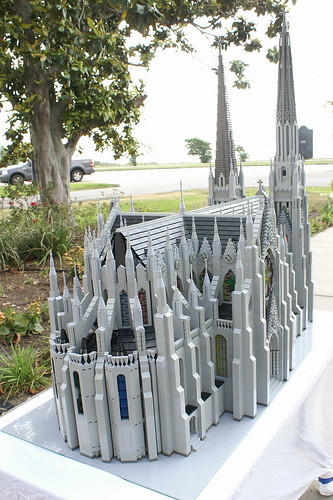

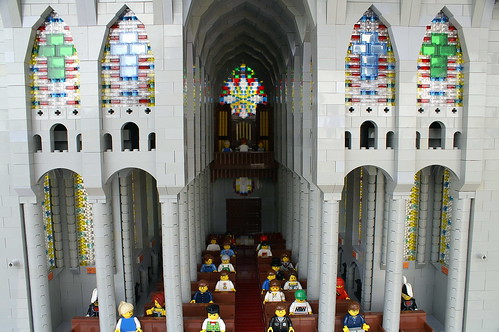




Thursday, May 6, 2010
On Authority
I'm way behind in the Brick Testament updates. I think to catch up I'll just do this in much smaller bites, one installment at a time, rather than wait until I have time to do a big chunk. So, on to On Authority. First up, the LEGO. As usual, these are all impeccable builds. In the first couple of scenes, the Nazi flags are all very striking, and I like that the Hitler scene is built into a corner rather than against a flat wall. With the American revolutionary soldiers, I really like how Brendan did the bayonets by, presumably, pinching the knives between the muskets and their hats. I can imagine that would have been very frustrating to set up and shoot. I'm not so thrilled on George Washington's hair. Those round plates look more like Princess Leia to me, or maybe earmuffs.
On the argument, Brendan is implying here that the clear reading of Scripture is that Christians are compelled support all kinds of dictators and never disagree with them. I understand that that is a possible reading, and that the divine right of kings was balanced on this passage. I do think, though, that Brendan is leaving aside a fuller reading of the Bible and millennia of Christian thought. Things aren't so cut and dried. For instance, Peter writes in an epistle that we should obey our rulers (1 Peter 2:13-17), but argued before the Sanhedrin that when the civic law opposes God's law, we should follow God's law (Acts 5:29). I would submit that the Christian view is that God established certain institutions among us - the family and government - to promote our well-being in this life. Of course those can become horribly dysfunctional, but that doesn't mean that the institutions themselves should be discarded. E.g. the fact that there are abusive parents doesn't negate the fact that I have both an authority and a duty under God in teaching my 2 year old that she has to go to bed on time and eat healthy foods etc. To take Brendan's implication the other way, we would say that just because governments can become tyrannical doesn't mean that there is not a proper place for civic authority in creating an ordered society. Where is the balance? I think Peter struck it in the two passages cited above. I think Paul struck it in the very passage Brendan cites. Romans 13:5 says that the civic authority is to punish the wrongdoer, not to kill off people the tyrant doesn't like. I also think that the American founders struck this in the Declaration of Independence (since Brendan's second image is of George Washington rebelling), in saying that we were created by God with certain rights, that government has a proper role under the Creator in protecting those and promoting civic order, but there comes a time when government does not live up to this charge it should be changed. In the context of Nazis, we should look to Dietrich Bonhoeffer's consideration of when it becomes lawful to oppose authorities and his ultimate involvement in a plot to assassinate Hitler. Basically put, my contention here is that Brendan has read a few verses and said 'here is a simplistic literal rendition', the exact thing that I'm guessing that he would criticize in a fundamentalist type of Christian (and where I would agree with him).
Two other thoughts: First, I'm afraid that Brendan has Godwinized himself here. Yes, there are proper places for Nazi analogies, but I don't think this is one of them. Second, while these are great illustrations, they may fall prey to less thoughtful use as they are copied and pasted all over the web. I've certainly seen Brendan's illustrations of slavery spread around in less than mature ways. Or you could see people using these pics to point out how horrible LEGO fans are, like we've seen before with the London Sun article on 'Osama Bin LEGO' and LEGO Nazis. For these reasons, while the Nazi scenes are great as LEGO illustrations and as powerful rhetorical devices, I kind of wish Brendan hadn't gone there.

On the argument, Brendan is implying here that the clear reading of Scripture is that Christians are compelled support all kinds of dictators and never disagree with them. I understand that that is a possible reading, and that the divine right of kings was balanced on this passage. I do think, though, that Brendan is leaving aside a fuller reading of the Bible and millennia of Christian thought. Things aren't so cut and dried. For instance, Peter writes in an epistle that we should obey our rulers (1 Peter 2:13-17), but argued before the Sanhedrin that when the civic law opposes God's law, we should follow God's law (Acts 5:29). I would submit that the Christian view is that God established certain institutions among us - the family and government - to promote our well-being in this life. Of course those can become horribly dysfunctional, but that doesn't mean that the institutions themselves should be discarded. E.g. the fact that there are abusive parents doesn't negate the fact that I have both an authority and a duty under God in teaching my 2 year old that she has to go to bed on time and eat healthy foods etc. To take Brendan's implication the other way, we would say that just because governments can become tyrannical doesn't mean that there is not a proper place for civic authority in creating an ordered society. Where is the balance? I think Peter struck it in the two passages cited above. I think Paul struck it in the very passage Brendan cites. Romans 13:5 says that the civic authority is to punish the wrongdoer, not to kill off people the tyrant doesn't like. I also think that the American founders struck this in the Declaration of Independence (since Brendan's second image is of George Washington rebelling), in saying that we were created by God with certain rights, that government has a proper role under the Creator in protecting those and promoting civic order, but there comes a time when government does not live up to this charge it should be changed. In the context of Nazis, we should look to Dietrich Bonhoeffer's consideration of when it becomes lawful to oppose authorities and his ultimate involvement in a plot to assassinate Hitler. Basically put, my contention here is that Brendan has read a few verses and said 'here is a simplistic literal rendition', the exact thing that I'm guessing that he would criticize in a fundamentalist type of Christian (and where I would agree with him).
Two other thoughts: First, I'm afraid that Brendan has Godwinized himself here. Yes, there are proper places for Nazi analogies, but I don't think this is one of them. Second, while these are great illustrations, they may fall prey to less thoughtful use as they are copied and pasted all over the web. I've certainly seen Brendan's illustrations of slavery spread around in less than mature ways. Or you could see people using these pics to point out how horrible LEGO fans are, like we've seen before with the London Sun article on 'Osama Bin LEGO' and LEGO Nazis. For these reasons, while the Nazi scenes are great as LEGO illustrations and as powerful rhetorical devices, I kind of wish Brendan hadn't gone there.

Sunday, May 2, 2010
Alamut
Dita Svelte presents a great rendition of the Citadel of Alamut for the Prince of Persia theme. Alamut was an actual fortress city in Persia between 840 and 1256. I include this here because the thin tower inside the city to the right-hand side of this image looks like a minaret to me, so I assume that structure next to it is a mosque.
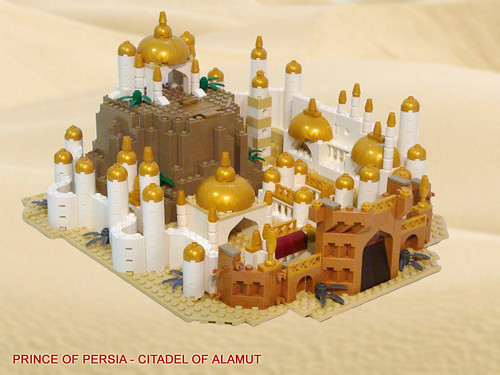
I go back and forth on the inclusion of creations in general from this area, as I understand this style to be called 'Islamic architecture'. I was corrected once when referring to it as 'Arabic', since, of course, there are a lot of Islamic areas (including Iran) that are not Arabic. 'Islamic architecture' styles can refer to religious structures such as mosques, and also tombs, which have a relation to religious themes, but also completely non-religious structures such as a fortresses or palaces.

I go back and forth on the inclusion of creations in general from this area, as I understand this style to be called 'Islamic architecture'. I was corrected once when referring to it as 'Arabic', since, of course, there are a lot of Islamic areas (including Iran) that are not Arabic. 'Islamic architecture' styles can refer to religious structures such as mosques, and also tombs, which have a relation to religious themes, but also completely non-religious structures such as a fortresses or palaces.
Subscribe to:
Posts (Atom)

